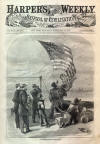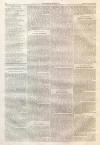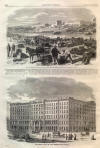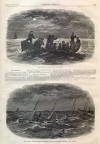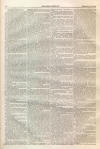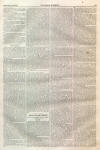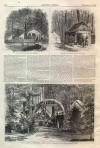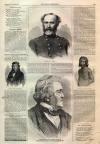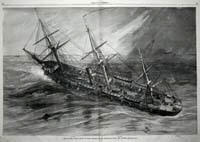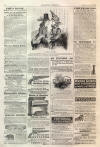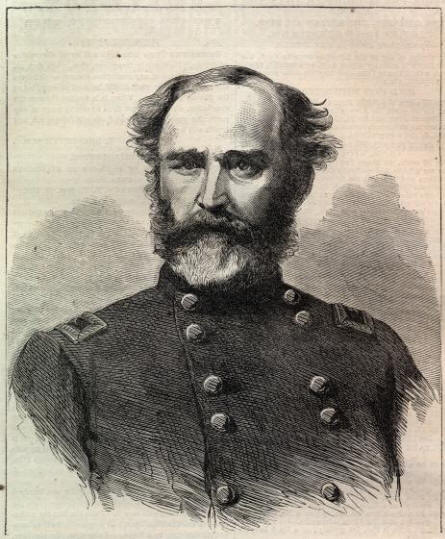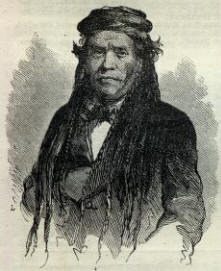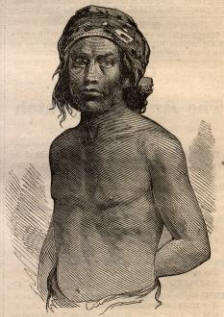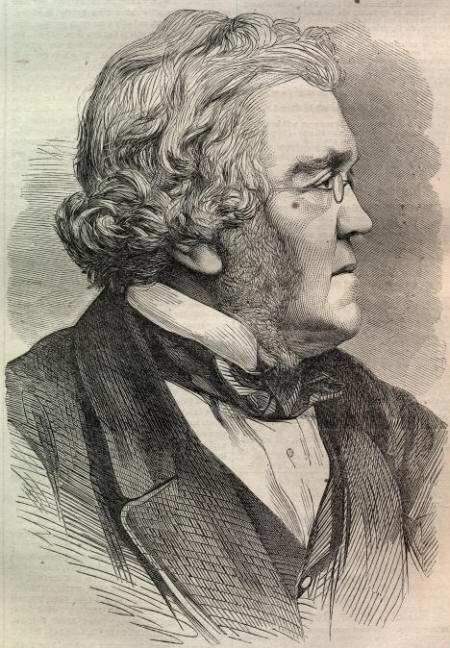|
This Site:
Civil War
Civil War Overview
Civil War 1861
Civil War 1862
Civil War 1863
Civil War 1864
Civil War 1865
Civil War Battles
Confederate Generals
Union Generals
Confederate History
Robert E. Lee
Civil War Medicine
Lincoln Assassination
Slavery
Site Search
Civil War Links
Civil War Art
Mexican War
Republic of Texas
Indians
Winslow Homer
Thomas Nast
Mathew Brady
Western Art
Civil War Gifts
Robert E. Lee Portrait
|
GENERAL M. C. MEIGS.
REMEMBRANCE.
THE turmoil of the busy world
May sweep across my path,
And storms may come, with seeming
power,
To crush me in their wrath;
Yet recollections of the past,
And of our friendship true,
Shall forge a firm, unyielding
chain
To bind my heart to you.
And when in after-years you read
Each page of Memory's book,
I would not wish my name might be
In some neglected nook;
But ask that when life's noon is
past,
And wanes its sunshine brief,
Within that volume I may claim
One bright, unsullied leaf.
GENERAL MEIGS.
GENERAL M. C. MEIGS, whose
portrait we here give, was born in Georgia. He was appointed to West Point from
Pennsylvania, in 1832, and was graduated at that institution in 1836, ranking
the fifth in his class, and receiving the appointment of Second Lieutenant First
Artillery. In November of the same year he was transferred to the Corps of
Engineers. He was promoted to a First Lieutenant of Artillery October 18, 1838.
Genreal Meigs was for some time overseer of the works involved in the extension
of the
Capitol at Washington, in the exercise of which duty his taste was no
less judicious than his skill. He also superintended the construction of the
Potomac Aqueduct, in which he planned an arch which is said to be the largest
arch of a single span in the world. At the beginning of the war he resigned his
position as First Lieutenant, and was appointed Quarter-master of the Army. At
present he is detailed by the Secretary on inspection duty in the West.
INDIAN CHIEFTAINS FROM THE
FAR WEST.
OUR readers will be interested to
know something about the two Indian Chiefs, IRATABA and ANTONIO AZUL, the most
powerful of all the chieftains
LRATABA, CHIEF OF THE MOJAVES.
west of the Rio Grande, whose
portraits we give on this page. Irataba left San Francisco on the 23d of
January, for a visit to Washington and New York. He is chief of the Mojaves—the
great tribe of the Colorado Valley—and is the finest specimen of the
unadulterated aboriginal on this continent. He rules over several subordinate
tribes with an iron hand. He is fifty-five years old, six feet in height, has a
magnificent bodily presence, and an amount of physical strength which enables
him to march fifty miles a day through the burning lands of Arizona. The only
thing which has yet excited an expression of wonder in his travels was the sight
of a school of whales on his way to San Francisco. Antonio Azul, the ally of
Irataba, is head chief of the Pimos of the Gila, and furnishes a striking
contrast to Irataba. His face betokens a frank and amiable disposition. His
tribe is very intelligent, and numbers 6000 men. The costume of the sketch is
that commonly worn by the tribes from the Rio Grande to the Colorado.
THE
LINDELL HOTEL OF ST.
LOUIS, MISSOURI.
THIS vast hotel, a view of which
appears on
page 100, is the work of an association, incorporated in 1855 under
the style of "Laclede Hotel Company." The name was derived from Pierre Ligueste
Laclede, the city's founder, who planted a colony on its site one hundred and
seventeen years ago, under the protection of France. Not far from the time of
laying the foundations in 1857, the name was changed by Legislative enactment to
"Lindell Hotel," in compliment to the brothers Jesse G. Lindell and Peter
Lindell, who were large contributors to the enterprise. Both of the brothers are
now dead—the latter dying less than a year since at the age of eighty-six. The
company proceeded unremittingly with their task, first under the Presidency of
Derrick A. January, and then under that of Levin H. Baker. After a lapse of
seven years they saw their Herculean labor completed. Mr. Thomas Walsh, who was
the architect in chief, besides drawing upon the ample resources of his own
skill, visited Europe for the purpose of examining the plans of the most
celebrated foreign hotels. His researches decided him to adopt and combine the
shops and courts of Italian and French models with the vestibule system of
England.
The main front looks southward
and lies on Washington Avenue; on the east side runs Sixth Street, on the west
Seventh Street, and on the north Green Street. The design is Italian, of the
Venetian school, and the building is of very substantial nature, being
constructed of brick, iron, and stone. The hotel consists of two parallel
buildings, extending east and west the length of the whole front, with
a space of forty-five feet
between them, and connected only in the centre, and both extremes by wing
buildings running north and south, and leaving between thorn two courts, one of
which is to be used for a gentleman's recreation, and the other for a lady's
conservatory. While the outer connecting buildings and the eastern flank extend
to the full depth of the lot, the space that would be occupied by the western
flank has been reserved for the erection of a theatre, to connect with the
building. The principal or southern front is divided into five compartments, on
its base line, the centre and both extreme divisions forming projections, and
the two receding divisions forming on the first and second stories colonnades
between them. The three principal elevators on the ground-floor are supported by
columns, imposts, and arches, forming a continuous arcade around the three
fronts, imparting strength to the building and allowing sufficient light for the
shops and basements. The pedestals of these columns extend down to the basement
floor, and are supported by inverted arches.The Lindell is six stories high
exclusive of attic and basement, both which are equivalent to nearly two stories
more. The height from sidewalk to cornice is one hundred and twelve feet. The
stone used (rich cream-colored magnesian limestone) is from the Grafton
quarries, not far above the mouth of the Illinois River. The east and south
fronts are of this stone, and
show much elaborate carving. The north and west fronts are faced with brick,
ornamented by cut-stone window trimmings.
The basement extends under the
entire structure, courts and sidewalks, and comprises the following: The
laundry, five rooms, a general linen-room, connected by steam-elevators with the
distributing-rooms on each story. The baker and pastry-cook have each two rooms;
the butcher and fish-monger have one large room each; the grocer and
green-grocer have one room each; there are twelve large wine-vaults and six
coal-vaults. The steam-engine and the boiler are outside the building. There
are, moreover, two dining-rooms for the hotel help and those of the guests of
the house, and a large saloon, 93 by 64 feet, to be used as a general bath-room.
There are other rooms of minor importance in the basement. Entering the first
story from Washington Avenue, the guest finds himself in a vestibule which has a
variegated marble floor, with columns supporting a handsomely frescoed ceiling.
In the courts in the eastern and western parts of the ground-floor are to be
separate colonnades for both sexes, ornamented with beautiful fountains,
evergreens, etc. On the same floor is the saloon, the billiard-room, public and
private offices, baggage-rooms, coat-room, wash-rooms, water-closets, and
vaults.
Encircling the public
offices are thirty-six commodious shops and stores connectingwith the interior
of the house by a walk all around the rear doors. These shops will be leased to
all kinds of dealers, railway companies, etc. Leaving the large vestibule, the
guest can ascend to the right or left of the main entrance to the second story,
which is reached by two grand staircases, running up the entire height of the
building. This story is divided into public and private parlors, reading and
writing rooms, ante-rooms, club rooms, etc., all spacious, lofty, and
magnificently furnished throughout. The gentlemen's public reception-room is
located over the main entrance, and is thirty-five by twenty-five feet. The
dining-rooms are on this floor.
The third story is divided into
sixteen suits of rooms for the accommodation of family parties. Each suit
comprises three or more rooms—a parlor, bedroom, wash and bath room, closets.
There are also on this floor over fifty single bedrooms for the accommodation of
transient guests and boarders who have no families.
The fourth, fifth, and sixth
stories are divided into suits of three or more rooms and single rooms. The
rooms are all very large, well lighted, ranging in size from thirteen by sixteen
feet to thirty-one by twenty-five—connected by spacious corridors twelve feet
wide by sixteen to twenty feet high, with triple windows (nearly the width of
the halls) at their extremities, give good ventilation, aided by twenty patent
ventilators through the roof. There is not a single dark room in the whole
building.
The whole building, faking it
from basement to attic, has 530 rooms. Those of public character are numerous
and capacious beyond those of any other hotel edifice on the continent.
The parlors are eighteen or
twenty in number, the whole second story front being one continuous range, and
adding
ANTONIO AZUL, CHIEF OF THE PIMOS.
those on the sides, the house has
a parlor range of more than one hundred yards. The furnishing of these parlors
is as rich as befits the general character of the edifice, consisting of
Axminster, Brussels, and English velvet carpets; brocatelle, satin damask, and
lace curtains; rosewood, walnut, and gilt mirrors; chairs, and sofas, generally
of Elizabethan, Louis XIV., and other renaissant styles.
The bricks laid on the walls
would be sufficient to pave an area of more than thirty-eight acres. There are
740 tons of cast and wrought iron, 27 acres of plastering, 810 windows, 650
inside doors. The plate-glass would cover an acre of ground, the floors seven
acres. The sheeting, or wash-boards, laid in a continuous line, would reach
thirteen miles. Besides the marble flooring and other flagging, 300,000 feet of
flooring boards have been laid, requiring 30,000 yards of carpet to cover them.
There are 32 tons of sash-weights, 16,000 feet of gas-pipe, 120,000 pounds of
lead and 30,000 of iron pipe for water, 87,700 feet of steam-pipe for heating
it, and 32 miles of bell-wire. The actual cost of the building is $950,000,
which, with the ground (valued at $326,400), makes the whole value
$1,276,400—not to speak of furniture, $200,000 worth of which is now being
imported and put in. So the house, fully completed and furnished, will cost
nearly a million and a half of dollars!
The lessees who have undertaken
the task of conducting this gigantic establishment are Messrs. JOHN H. SPARR and
JOHN C. PARKS. Both have long been known in the West as accomplished hosts, and
had previously been associated together in the proprietorship of hotels in St.
Louis. The "Lindell" was formally inaugurated on the 25th of November by a grand
"Opening Ball." Nearly three thousand persons, from quite half the States of the
Union were present. There were five orchestras, to whose music 120 sets, or 700
dancers, occupied the floor at a time. The whole affair was most successfully
conducted, and furnished a fitting prelude to the opening of the largest and
most magnificent hotel in tile country, and the largest in the world, with the
possible exception of the Hotel de la Paix, of Paris.
THE LOVER'S WISH.
I WOULD not be the rose that
blooms
Where gay parterres are spread,
Nor yet the rosy wreath that
twines
Round beauty's graceful head.
No! let me be the rose that wins
A glance and smile from thee
When none are by, thy beating
heart,
Thy blushing cheek, to see:
Long treasured for the giver's
sake,
When nature's charms are past;
And claiming still, though dry
and sere,
A fond look to the last.
WILLIAM MAKEPEACE THACKERAY, AETAT. 52.
BORN IN CALCUTTA A.D. 1811: DIED AT LONDON,
DECEMBER 24, 1863.
|
